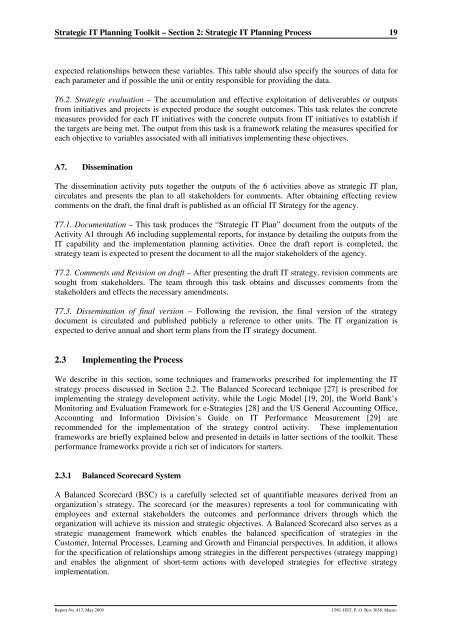Strategic IT Planning for Public Organizations: A Toolkit - UNU-IIST ...
Strategic IT Planning for Public Organizations: A Toolkit - UNU-IIST ...
Strategic IT Planning for Public Organizations: A Toolkit - UNU-IIST ...
You also want an ePaper? Increase the reach of your titles
YUMPU automatically turns print PDFs into web optimized ePapers that Google loves.
<strong>Strategic</strong> <strong>IT</strong> <strong>Planning</strong> <strong>Toolkit</strong> – Section 2: <strong>Strategic</strong> <strong>IT</strong> <strong>Planning</strong> Process<br />
19<br />
expected relationships between these variables. This table should also specify the sources of data <strong>for</strong><br />
each parameter and if possible the unit or entity responsible <strong>for</strong> providing the data.<br />
T6.2. <strong>Strategic</strong> evaluation – The accumulation and effective exploitation of deliverables or outputs<br />
from initiatives and projects is expected produce the sought outcomes. This task relates the concrete<br />
measures provided <strong>for</strong> each <strong>IT</strong> initiatives with the concrete outputs from <strong>IT</strong> initiatives to establish if<br />
the targets are being met. The output from this task is a framework relating the measures specified <strong>for</strong><br />
each objective to variables associated with all initiatives implementing these objectives.<br />
A7. Dissemination<br />
The dissemination activity puts together the outputs of the 6 activities above as strategic <strong>IT</strong> plan,<br />
circulates and presents the plan to all stakeholders <strong>for</strong> comments. After obtaining effecting review<br />
comments on the draft, the final draft is published as an official <strong>IT</strong> Strategy <strong>for</strong> the agency.<br />
T7.1. Documentation – This task produces the “<strong>Strategic</strong> <strong>IT</strong> Plan” document from the outputs of the<br />
Activity A1 through A6 including supplemental reports, <strong>for</strong> instance by detailing the outputs from the<br />
<strong>IT</strong> capability and the implementation planning activities. Once the draft report is completed, the<br />
strategy team is expected to present the document to all the major stakeholders of the agency.<br />
T7.2. Comments and Revision on draft – After presenting the draft <strong>IT</strong> strategy, revision comments are<br />
sought from stakeholders. The team through this task obtains and discusses comments from the<br />
stakeholders and effects the necessary amendments.<br />
T7.3. Dissemination of final version – Following the revision, the final version of the strategy<br />
document is circulated and published publicly a reference to other units. The <strong>IT</strong> organization is<br />
expected to derive annual and short term plans from the <strong>IT</strong> strategy document.<br />
2.3 Implementing the Process<br />
We describe in this section, some techniques and frameworks prescribed <strong>for</strong> implementing the <strong>IT</strong><br />
strategy process discussed in Section 2.2. The Balanced Scorecard technique [27] is prescribed <strong>for</strong><br />
implementing the strategy development activity, while the Logic Model [19, 20], the World Bank’s<br />
Monitoring and Evaluation Framework <strong>for</strong> e-Strategies [28] and the US General Accounting Office,<br />
Accounting and In<strong>for</strong>mation Division’s Guide on <strong>IT</strong> Per<strong>for</strong>mance Measurement [29] are<br />
recommended <strong>for</strong> the implementation of the strategy control activity. These implementation<br />
frameworks are briefly explained below and presented in details in latter sections of the toolkit. These<br />
per<strong>for</strong>mance frameworks provide a rich set of indicators <strong>for</strong> starters.<br />
2.3.1 Balanced Scorecard System<br />
A Balanced Scorecard (BSC) is a carefully selected set of quantifiable measures derived from an<br />
organization’s strategy. The scorecard (or the measures) represents a tool <strong>for</strong> communicating with<br />
employees and external stakeholders the outcomes and per<strong>for</strong>mance drivers through which the<br />
organization will achieve its mission and strategic objectives. A Balanced Scorecard also serves as a<br />
strategic management framework which enables the balanced specification of strategies in the<br />
Customer, Internal Processes, Learning and Growth and Financial perspectives. In addition, it allows<br />
<strong>for</strong> the specification of relationships among strategies in the different perspectives (strategy mapping)<br />
and enables the alignment of short-term actions with developed strategies <strong>for</strong> effective strategy<br />
implementation.<br />
Report No. 417, May 2009<br />
<strong>UNU</strong>-<strong>IIST</strong>, P. O. Box 3058, Macao

















